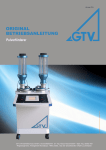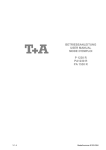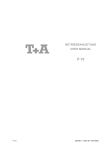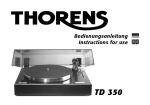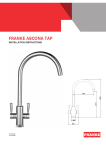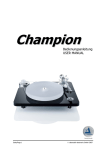Download BETRIEBSANLEITUNG USER MANUAL G 1260 R
Transcript
V 1.0 BETRIEBSANLEITUNG USER MANUAL G 1260 R Bestellnr. / Order No. 9103-0425 DE/UK 2 Seite / Page Deutsch English ............................................................................................................. 4 .............................................................................................................. 22 Anhang / Appendix: Technische Daten / Technical specifications .......... 3 39 Willkommen. Wir freuen uns, dass Sie sich für ein -Produkt entschieden haben. Mit Ihrem neuen Plattenspieler G 1260 R haben Sie ein HiFi-Gerät der Spitzenklasse erworben, bei dessen Konzeption und Entwicklung den Wünschen des audiophilen Musikliebhabers oberste Priorität eingeräumt wurde. Die innovativen Problemlösungen, die solide, durchdachte Konstruktion und die verwendeten hochwertigen Materialien werden dazu beitragen, dass dieses Gerät höchsten Anforderungen und Ansprüchen über viele Jahre genügen wird. Eine genaue Qualitätsprüfung aller Materialien, die sorgfältige Produktion durch hochqualifizierte Fachkräfte und eine rechnergesteuerte, vollautomatisierte Endkontrolle gewährleisten die hohe Produktqualität und die Einhaltung aller Spezifikationen. In unserer Geräteproduktion wird der Einsatz aller umwelt- und gesundheitsgefährdenden Stoffe, wie z. B. chlorhaltige Lösungsmittel und FCKWs, vermieden. Darüber hinaus verzichten wir wo irgend möglich auf Kunststoffe (insbesondere auf PVC) als Konstruktionselement. Statt dessen wird auf Metalle oder andere unbedenkliche Materialien zurückgegriffen, die einerseits gut recyclebar sind und andererseits eine sehr gute elektrische Abschirmung ergeben. Durch unsere massiven Ganzmetallgehäuse wird eine Beeinträchtigung der Wiedergabequalität durch äußere Störquellen ausgeschlossen. Dadurch wird sichergestellt, dass die von den Geräten ausgehende elektromagnetische Strahlung (Elektrosmog) gut abgeschirmt und auf ein absolutes Minimum reduziert wird. Als Sonderzubehör sind hochwertige Kabel und Steckverbinder sowie auf das Gerätedesign abgestimmte Tonmöbel lieferbar. Wir bedanken uns für Ihr Vertrauen und wünschen Ihnen viel Freude und Hörvergnügen mit Ihrem Plattenspieler. elektroakustik GmbH & Co KG Alle verwendeten Bauteile entsprechen den geltenden deutschen und europäischen Sicherheitsnormen und -standards. Zu Ihrer eigenen Sicherheit sollten Sie bitte unbedingt diese Betriebsanleitung vollständig lesen und insbesondere die Aufstellungs-, Betriebs- und Sicherheitshinweise genau befolgen. Dieses Produkt entspricht den Niederspannungsrichtlinien (73/23/EEC), EMV-Richtlinien (89/336/EEC, 92/31/EEC) und den CE-Markierungsrichtlinien (93/68/EEC). 4 Inhaltsverzeichnis Bedienung Bedienelemente der Frontseite ....................................................................................... 6 Abspielen einer Schallplatte ............................................................................................ 6 Anschluss und Inbetriebnahme Anschlusselemente an der Rückseite ............................................................................ 8 Aufstellung und Verkabelung .......................................................................................... 9 Montage des Plattentellers ............................................................................................ 11 Montage des Gegengewichts und Kontrolle der Tonarmeinstellung ............................. 13 Einbau und Ausrichtung eines Tonabnehmersystems .................................................. 14 Sicherheitshinweise ....................................................................................................... 15 Der G 1260 R PHONO Vorverstärker (optional) ........................................................... 17 Einstellungen der Codierschalter ................................................................................... 18 Betriebsstörungen ......................................................................................................... 19 Anhang Technische Daten .......................................................................................................... 39 5 Bedienelemente der Frontseite (Ein- und Ausschalter) Kurzes Antippen des -Tasters schaltet das Gerät ein und aus. Bei eingeschaltetem Gerät leuchtet die LED über dem Taster. Bei Betrieb in Verbindung mit einer R-Anlage schaltet sich der G 1260 R über die bestehende RLink-Verbindung ein, sobald ein Phonoeingang („AUX1“ oder „AUX2“) als Hörquelle gewählt wird. Beim Ausschalten der R-Anlage schaltet sich der G 1260 R automatisch aus. Achtung! Der Netztaster ist kein Netztrenner. Auch wenn die Leuchtdiode ausgeschaltet ist, sind Teile des Gerätes mit der Netzspannung verbunden (Standby-Betrieb). Die Standby-Stromaufnahme ist im Kapitel „Technischen Daten“ angegeben. Soll das Gerät längere Zeit nicht benutzt werden, ist es vorteilhaft, den Netzstecker zu ziehen. Taster zur Wahl der Drehgeschwindigkeit Bei stehendem Plattenteller startet ein Druck auf einen der Taster den Tellermotor mit der über dem Taster angegebenen Drehgeschwindigkeit. Während des Hochlaufens des Motors blinkt die LED über dem Taster. Sobald die Sollgeschwindigkeit erreicht ist leuchtet die LED dauerhaft. Zum Umschalten der Geschwindikeit tippen Sie einfach auf den anderen der beiden Taster. 33 / 45 Stoppen des Tellermotors Tippen Sie bei drehendem Plattenteller den Taster unter der leuchtenden LED an, so wird der Plattenteller aktiv gebremst und kommt nach kurzer Zeit zum Stillstand. Abspielen einer Schallplatte Bedienung • • • • • Schalten Sie das Gerät durch kurzes Antippen des Tasters ein. Legen Sie die Schallplatte auf den Plattenteller. Vor jedem Abspiel empfehlen wir, den Oberflächenstaub auf der Platte z. B. mit Hilfe einer Kohlfaserbürste oder eines Antistatiktuches zu entfernen. Drücken Sie den 33 oder 45 UpM Taster (entsprechend der aufgelegten Schallplatte), um den Motor zu starten. Schwenken Sie den Tonarm nach innen über die gewünschte Rille. Leuchtet die LED über dem gedrückten Taster dauerhaft, ist die Solldrehzahl erreicht und der Tonarm kann durch Betätigen des Tonarmlifthebels (siehe Abbildung 'Einstellelemente des Tonarms', Kapitel 'Montage des Gegengewichts und Kontrolle der Tonarmeinstellungen') langsam abgesenkt werden. Die optional erhältliche Haube muss zum Betrieb des G 1260 R entfernt werden. 6 Installation Inbetriebnahme Sicherheitshinweise In diesem Kapitel werden alle Dinge von grundsätzlicher Bedeutung für die Aufstellung und Inbetriebnahme beschrieben, die nicht für den täglichen Umgang mit dem Gerät relevant sind, die aber trotzdem vor dem ersten Gebrauch gelesen und beachtet werden sollten. 7 Anschlusselemente GND Erdungsklemme Nur für G 1260 R Version ohne eingebautes Phonomodul: Verbinden Sie diesen Anschluss mit der Erdungsklemme an Ihrem Verstärker. Bei G 1260 R mit Phonomodul bleibt diese Klemme unbenutzt. OUT Ausgangsbuchsen Bei G 1260 R Versionen ohne eingebautes PHONO Vorverstärkermodul: Verbinden Sie diese Buchsen mit einem PHONO-Eingang Ihres Verstärkers Bitte beachten Sie, dass wenn im G 1260 R kein Phonomodul eingebaut ist, dieses im Verstärker / Receiver vorhanden sein muss. Bei im G 1260 R eingebautem PHONO Vorverstärkermodul: Verbinden Sie diese Buchsen mit einem Hochpegeleingang (Line-Eingang) Ihres Verstärkers. Verwenden Sie je nach Verstärkermodell einen der folgenden Eingänge zum Anschluss des G 1260 R: Eingang Gerät AUX 2 P1230/1260R, PA1230/1260R, PA1530R, R1530 R AUX1 R1230R R LINK Steuereingang zum Anschluss an Geräte mit RLINK-Steuerung (z. B. an den Verstärker PA 1260 R). Netzeingang Diese Buchse dient dem Netzanschluss. 8 Aufstellung und Verkabelung Packen Sie den G 1260 R vorsichtig aus und heben Sie die Originalverpackung sorgfältig auf. Der Karton und das Verpackungsmaterial sind speziell für dieses Gerät konzipiert und bei späteren Transporten ein sicherer Behälter. Bitte beachten Sie unbedingt die Sicherheitshinweise dieser Anleitung. War das Gerät größerer Kälte ausgesetzt (z. B. beim Transport), so ist mit der Inbetriebnahme zu warten, bis sich das Gerät auf Raumtemperatur aufgewärmt hat und das Kondenswasser restlos verdunstet ist. Vor der Aufstellung des Gerätes auf empfindlichen Flächen sollte ggf. an einer nicht sichtbaren Stelle die Verträglichkeit des Lackes mit den Gerätefüßen überprüft werden. Das Gerät ist waagerecht auf einer festen, ebenen und nicht schwingenden Unterlage aufzustellen. Die Füße sind mit Schwingmetallen entkoppelt und dadurch beweglich. Bei Aufstellung auf Resonanzdämpfern oder Entkopplungsgliedern ist darauf zu achten, dass die Standsicherheit des Gerätes nicht beeinträchtigt wird. Die Aufstellung darf nur an einem gut belüfteten, trockenen Ort erfolgen, wobei direkte Sonneneinstrahlung und die Nähe von Heizkörpern zu vermeiden sind. Das Gerät darf nicht in der Nähe von wärmeproduzierenden, wärmeempfindlichen oder leicht brennbaren Gegenständen bzw. Geräten aufgestellt werden. Sorgen Sie beim Einbau in Regale oder Schränke deshalb unbedingt für ausreichende Luftzufuhr und sorgen Sie dafür, dass die Wärme des Gerätes abgeführt werden kann. Ein Wärmestau beeinträchtigt die Lebensdauer des Gerätes und ist eine Gefahrenquelle. Verlegen Sie Netz- oder Lautsprecher- und Fernbedienungskabel möglichst entfernt von Ton- und Antennenleitungen und keinesfalls über oder unter dem Gerät. Hinweise zum Anschluss: • Stecken Sie alle Stecker fest in die Buchsen ein. Lockere Steckverbindungen können Brummen oder andere Störgeräusche verursachen. • Zur Erreichung des maximalen Störabstandes sollte der Netzstecker so in die Netzsteckdose gesteckt werden, dass die Phase an dem Kontakt der Netzeingangsbuchse angeschlossen wird, der mit einem Punkt () gekennzeichnet ist. Die Phase der Netzsteckdose kann mit einem dafür geeigneten Messgerät ermittelt werden. Wenden Sie sich bitte an Ihren Fachhändler. • Wir empfehlen die Verwendung der konfektionierten –Netzkabel 'POWER LINE' in Kombination mit der Netzsteckdosenleiste 'POWER BAR', die mit Phasenindikator ausgestattet ist. • Nachdem die Anlage vollständig verkabelt ist, stellen Sie bitte den Lautstärkeregler auf eine sehr geringe Lautstärke und schalten Sie die Anlage ein. Falls bei der Inbetriebnahme des Gerätes Probleme auftreten sollten, haben diese oftmals einfache Ursachen, die leicht zu beheben sind. Lesen Sie dazu das Kapitel 'Betriebsstörungen' dieser Betriebsanleitung. 9 Lautsprecher- und Signalkabel Die verwendeten Lautsprecher- und Signalkabel haben einen nicht zu unterschätzenden Einfluss auf die Wiedergabequalität der Gesamtanlage. empfiehlt daher die Verwendung hochwertiger Kabel und Steckverbinder. In unserem Zubehörprogramm finden Sie eine Reihe exzellenter Kabel und Stecker, die in ihren Eigenschaften auf unsere Lautsprecher und Elektronikkomponenten abgestimmt sind und hervorragend mit diesen harmonieren. Für schwierige und beengte Aufstellungsbedingungen finden Sie im Zubehör auch Kabel in Sonderlängen und Sonderstecker (z. B. in abgewinkelter Form), mit deren Hilfe sich fast jedes Anschluss- und Aufstellungsproblem lösen lässt. Netzkabel und Netzfilter Über die Netzstromversorgung gelangt nicht nur die notwendige Betriebsenergie zu Ihren Geräten, sondern oft auch Störungen von entfernten Geräten, Funk- und Computeranlagen. Um elektromagnetische Störungen von unser Zubehörprogramm das speziell FOUR', das konfektionierte Netzkabel mit die Netzfilterleiste 'POWER BAR'. Wiedergabequalität unserer Geräte in werden. den Geräten fern zu halten, bietet abgeschirmte Netzkabel 'POWER Mantelkernfiltern 'POWER LINE' und Mit diesem Zubehör kann die vielen Fällen nochmals gesteigert Zu allen Fragen rund um die Verkabelung berät Sie gern Ihr Fachhändler kompetent, umfassend und unverbindlich. Gern senden wir Ihnen auch unser umfangreiches Informationsmaterial zu diesem Thema. Mechanische Entkopplung Die Standfläche und der Untergrund, auf dem hochwertige HiFi-Geräte aufgestellt werden, haben einen nicht zu unterschätzenden Einfluss auf die erreichbare Klangqualität. Die Standfläche sollte möglichst schwer, stabil, hart und eben sein. Das Gerät ist mit den neuentwickelten Vibrationsabsorberfüßen ausgestattet. Diese Füße erreichen durch ihre inneren Dämpfungseigenschaften eine sehr gute Entkopplung des Gerätes vom Untergrund. Hierdurch werden Vibrationen des Untergrundes aufgefangen und das Tonabnehmersystem wird vor Mikrophoniestörungen geschützt. Damit die Vibrationsabsorber einwandfrei funktionieren können, sollte das Gerät frei aufgestellt werden. Ein Kontakt des Gehäuses mit Wänden usw. sollte vermieden werden. Pflege des Gerätes Vor Reinigungsarbeiten am Gerät ist der Netzstecker zu ziehen. Die Oberflächen des Gerätes sollten zur Reinigung nur mit einem angefeuchtete weichen Tuch oder Schwamm abgewischt werden. Nicht trocken abreiben. Zum Anfeuchten des Tuches verwenden Sie bitte ausschließlich Wasser ggf. mit etwas mildem Reinigungsmittel wie z. B. Neutralreiniger, Schmierseife oder ähnlichem. Verwenden Sie niemals organische Lösungsmittel, die z. B. Verdünnung, Alkohol oder Kraftstoffe enthalten können. Vor der Wiederinbetriebnahme muss sichergestellt sein, dass keine Kurzschlüsse an den Anschlussstellen bestehen und dass alle Anschlüsse ordnungsgemäß sind. 10 Montage des Plattentellers Wichtiger Hinweis für die folgenden Montageschritte: Bitte vermeiden Sie unbedingt, dass Öl auf den Treibriemen oder die Riemenscheibe gelangt! Achten Sie darauf, dass kein Schmutz in das Tellerlager gelangt. 1. Ziehen Sie die Riemenscheibe ( ) mitsamt der Plattentellerachse aus dem Tellerlager. 2. Entfernen Sie die Transportsicherung ( ). 3. Ölen Sie die Plattentellerachse / Lagerbuchse im Plattenteller mit der beigefügten Ölspritze gut ein. 4. Setzen Sie die Plattentellerachse unter leichtem Drehen mit leichtem Druck wieder in die Lagerbuchse ein. Dabei beachten Sie bitte, dass sich die Achse im Lager nicht verkantet. Die Achse muss leicht in das Lager gleiten. 5. Drücken Sie die Riemenscheibe so weit wie möglich nach unten. Die Riemenscheibe sinkt langsam auf der Lagerachse nach unten. Warten Sie, bis er auf der Lagerspitze aufliegt. Hinweis: Aufgrund des extrem geringen Lagerspiels kann es einige Zeit dauern, bis alle Luft aus dem Lager entwichen ist und sich die Achse ganz im Lager gesetzt hat. Dieser Vorgang kann einige Zeit in Anspruch nehmen (bis zu 30 Min.). 11 6. Wenn die Riemenscheibe ihre Endlage erreicht hat, kontrollieren Sie bitte, ob sich die Scheibe leicht von Hand drehen lässt. 7. Legen Sie den Treibriemen wie in der Abbildung gezeigt um das Tellerantriebsrad ( ) und die Riemenscheibe ( ). 8. Setzen Sie den Plattenteller vorsichtig und senkrecht auf die Lagerachse auf. 9. Legen Sie nun die Gummimatte auf den Plattenteller auf. 12 Montage des Gegengewichts und Kontrolle der Tonarmeinstellungen Tonarminfos Der TA 301 A Tonarm ist ein Präzisionsinstrument, welches mit höchster Genauigkeit gefertigt und justiert wurde. Um seine hervorragenden Abtasteigenschaften zu erhalten sollten alle Teile des Tonarms äußerst vorsichtig behandelt werden. Bei Einhaltung der folgenden Hinweise wird sich der Tonarm als ein zuverlässiges Produkt erweisen, das Ihnen für viele Jahre Musikgenuß auf höchstem Niveau, kombiniert mit einfacher Handhabung garantiert. Einstellung der Auflagekraft Bei G1260R Modellen, die ohne das optional erhältliche Tonabnehmersystem geliefert werden installieren Sie bitte zuerst Ihr System und justieren Sie es wie im Kapitel „Einbau und Ausrichtung eines Tonabnehmersystems“ beschrieben. Bei G1260R Modellen, die ab Werk mit montiertem Tonabnehmersystem geliefert werden ist das System bereits korrekt justiert und optimal eingestellt. Bei Auslieferung ist das Tonarmgegengewicht vom Tonarm abgenommen, um das empfindliche Tonarmlager zu schonen. Das Gegengewicht befindet sich im Zubehör und muss vor Inbetriebnahme installiert und eingestellt werden. Stecken Sie dazu das Tonarmgewicht auf das hintere Ende des Tonarms auf. Stellen Sie das seitlich am Lager des Arms befindliche Einstellrad für das Auflagegewicht auf „0“. Wenn der Arm am vorderen Ende nun nach unten hängt, schieben Sie das Tonarmgewicht weiter nach hinten, steigt das vordere Ende des Arms auf, bewegen Sie das Tonarmgewicht weiter nach vorn. Bringen Sie auf diese Weise das Gewicht in die Position, in der der Arm knapp über der Plattentellerebene „schwebt“ und sich selbstätig weder aufwärts- noch abwärts bewegt. Nun kann die vom Hersteller Ihres Tonabnehmersystems empfohlene Auflagekraft durch Drehen des Einstellrades für das Auflagegewicht eingestellt werden. Einstellung der Antiskatingkraft Hinweis: In der Regel empfiehlt sich eine Einstellung der Auflagekraft an der oberen Grenze des vom Hersteller des Systems genannten Bereiches. Die Antiskatingkraft wird mit dem Schieberegler an der Tonarmbasis eingestellt. Die Markierungen der Skala an diesem Regler korrespondieren mit der Auflagekraft des Tonabnehmersystems in Gramm. Wenn Sie z.B. eine Auflagekraft von 1,5g eingestellt haben, stellen Sie den Schieberegler bitte ebenfalls auf einen Wert von 1,5 ein. Einstellelemente des Tonarms 13 Einbau und Ausrichtung eines Tonabnehmersystems Einbau Tonabnehmersystem Befestigen Sie das Tonabnehmersystem (2) mit geeigneten Schrauben (4) und Muttern (3) in den Langlöchern am vorderen Ende des Tonarms (1). Stecken Sie die aus dem Arm ragenden Kabel an den Anschlußstiften des Tonabnehmersystems gemäß folgender Tabelle auf. Blau Weiß Grün Rot Ausrichtung Tonabnehmersystem Masse – linker Kanal Signal – linker Kanal Masse – rechter Kanal Signal – rechter Kanal Legen Sie die im Zubehör des G1260R befindliche Schablone so auf den Plattenteller auf, dass die Plattentellerachse durch das Loch in der Schablone greift. Lösen Sie die Schrauben des Tonabnehmersystems ein wenig, sodaß Sie das System in den Langlöchern des Arms bewegen können. Schwenken Sie den Tonarm über das Linienmuster auf der Schablone und richten Sie das Tonabnehmersystem wie auf der Schablone dargestellt aus. Ziehen Sie dann die Halteschrauben des Systems fest an. 14 Sicherheitshinweise Alle in diesem Gerät verwendeten Bauteile entsprechen den geltenden deutschen und europäischen Sicherheitsnormen und -standards. Eine genaue Qualitätsprüfung aller Materialien, die sorgfältige Produktion, sowie die vollautomatische, rechnergesteuerte Endkontrolle eines jeden Gerätes gewährleisten die hohe Produktqualität und die Einhaltung aller Spezifikationen. Zu Ihrer eigenen Sicherheit sollten Sie bitte unbedingt diese Betriebsanleitung vollständig lesen und insbesondere die Aufstellungs-, Betriebs- und Sicherheitshinweise genau befolgen. Aufstellung Das Gerät ist so aufzustellen, dass eine Berührung sämtlicher Geräteanschlüsse (insbesondere durch Kinder) ausgeschlossen ist. Die Hinweise und Angaben im Kapitel 'Aufstellung und Verkabelung' sind unbedingt zu beachten. Stromversorgung Die für das Gerät erforderliche Stromversorgung ist dem Aufdruck an der Netzgerätebuchse zu entnehmen. An andere Stromversorgungen darf das Gerät nicht angeschlossen werden. Bei längerer Nichtbenutzung sollte der Netzstecker des Gerätes aus der Steckdose gezogen werden. Netzkabel / Netzstecker Netzkabel müssen so verlegt werden, dass keine Gefahr der Beschädigung (z. B. durch Trittbelastung oder durch Möbelstücke) besteht. Besondere Vorsicht ist dabei an den Steckern, Verteilern und an den Anschlussstellen des Gerätes geboten. Abziehen des Netzsteckers trennt das Gerät bei Wartung oder Servicearbeiten vom Netz. Bitte achten Sie darauf, dass der Stecker ohne Schwierigkeiten zugänglich und benutzbar ist. Geräteöffnungen Durch die Lüftungsschlitze dürfen keine Flüssigkeiten oder Fremdkörper in das Gerät gelangen. Im Inneren führt das Gerät Netzspannung, es besteht die Gefahr eines tödlichen elektrischen Schlages. Auf den Netzstecker darf keine übermäßige Krafteinwirkung ausgeübt werden. Schützen Sie das Gerät vor Tropf- und Spritzwasser und stellen Sie keine Blumenvasen oder andere Gefäße mit Flüssigkeiten auf das Gerät. Aufsichtspflicht Wie alle Elektrogeräte so sollte auch dieses Gerät nicht unbeaufsichtigt betrieben werden. Es ist darauf zu achten, dass es für kleine Kinder unerreichbar ist. Reparatur und Beschädigung Das Gerät darf nur vom qualifizierten Fachmann geöffnet werden. Reparaturen und das Auswechseln von Sicherungen sind von einer autorisierten Fachwerkstatt durchzuführen. Außer den in der Betriebsanleitung beschriebenen Handgriffen dürfen vom Benutzer keinerlei Arbeiten am Gerät vorgenommen werden. Bei Beschädigungen oder bei Verdacht auf eine nicht ordnungsgemäße Funktion des Gerätes sollte sofort der Netzstecker gezogen und das Gerät zur Überprüfung in eine autorisierte Fachwerkstatt gegeben werden. Überspannungen im Stromversorgungsnetz, dem Kabelnetz oder auf Antennenanlagen, wie sie z. B. bei Gewittern (Blitzschlag) oder statischen Entladungen auftreten können, stellen eine Gefährdung für das Gerät dar. Überspannung Spezielle Vorschaltgeräte, wie Überspannungsprotektoren oder die 'Power Bar' Netzanschlussleiste, bieten einen gewissen Schutz vor Gerätebeschädigungen aus o.g. Gründen. Eine absolute Sicherheit vor Beschädigung durch Überspannungen kann aber nur eine vollständige Trennung des Gerätes vom Netz und den Antennenanlagen gewährleisten. Ziehen Sie zur Trennung sämtliche Netz- und Antennenstecker Ihrer HiFi Anlage bei Überspannungsgefahr (z. B. bei heraufziehenden Gewittern) aus den Steckdosen. Sämtliche Netzversorgungs- und Antennenanlagen, an die das Gerät angeschlossen wird, müssen den geltenden Bestimmungen entsprechen und fachgerecht von einem zugelassenen Installationsbetrieb ausgeführt sein. Viele Versicherungsgesellschaften bieten im Rahmen der Hausratversicherung eine Blitzschutzversicherung für Elektrogeräte an. 15 Das Gerät ist ausschließlich zur Ton- und/oder Bildwiedergabe im Heimbereich in trockenen Räumen unter Berücksichtigung aller in dieser Anleitung gemachten Angaben bestimmt. Bestimmungsgemäßer Gebrauch Bei allen anderen Einsatzzwecken, insbesondere in medizinischen oder sicherheitsrelevanten Bereichen, ist vorher die Zulassung und Eignung des Gerätes für diesen Einsatz mit dem Hersteller abzuklären und schriftlich genehmigen zu lassen. Geräte mit Rundfunk- oder Fernsehempfangsteilen dürfen im Rahmen der gültigen 'Allgemeingenehmigung für Tonund FernsehRundfunkempfänger', veröffentlicht im Amtsblatt des Bundesministers für Post und Telekommunikation, in der Bundesrepublik Deutschland betrieben werden. Mit dem Gerät dürfen nur Aussendungen empfangen oder wiedergegeben werden, die für die Allgemeinheit bestimmt sind. Der Empfang oder die Wiedergabe anderer Aussendungen (z. B. des Polizei- oder Mobilfunks) ist nicht gestattet. Das Gerät entspricht im Originalzustand allen derzeit gültigen deutschen und europäischen Vorschriften. Es ist zum bestimmungsgemäßen Gebrauch in der EG zugelassen. Gerätezulassung und Konformität mit EGRichtlinien Durch das am Gerät befindliche Zeichen erklärt die Konformität mit den EG-Richtlinien 2006/95/EG und 2004/108/EG und den daraus abgeleiteten nationalen Gesetzen. Die unveränderte, unverfälschte Werksseriennummer muss außen am Gerät vorhanden und gut lesbar sein! Die Seriennummer ist Bestandteil unserer Konformitätserklärung und damit der Betriebszulassung des Gerätes! Seriennummern am Gerät und in den originalen Begleitpapieren (insbesondere den Kontroll- und Garantiezertifikaten) dürfen nicht entfernt oder verändert werden und müssen übereinstimmen. Bei Verstoß gegen diese Bestimmungen gilt die Konformitätszusage von als widerrufen und ein Betrieb des Gerätes innerhalb der EG ist untersagt und aufgrund geltender EG und nationaler Gesetze unter Strafandrohung verboten. Durch Umbauten am Gerät oder durch Reparaturen oder sonstige Eingriffe von nicht von autorisierten Werkstätten oder sonstigen Dritten verliert das Gerät seine Zulassung und Betriebserlaubnis. An das Gerät dürfen nur original Zubehörteile oder solche Zusatzgeräte angeschlossen werden, die ihrerseits zugelassen sind und allen geltenden gesetzlichen Vorschriften genügen. Auch mit Zusatzgeräten oder als Teil einer Anlage darf das Gerät nur zu den im Abschnitt 'Bestimmungsgemäßer Gebrauch' genannten Anwendungen eingesetzt werden. Entsorgung des Gerätes Für die spätere Entsorgung dieses Produkts stehen örtliche Sammelstellen für Elektroschrott zur Verfügung. 16 Der G 1260 R PHONO Vorverstärker (optional) Der G 1260 R kann mit einem optionalen Phono-Vorverstärker ausgerüstet werden. Sofern werksseitig Phonovorverstärker und Tonabnehmersystem installiert sind, sind diese bereits werksseitig optimal eingestellt. Die in diesem Kapitel beschriebenen Einstellungen brauchen in diesem Falle nicht durchgeführt werden. Im Falle, dass ein fremdes Tonabnehmersystem montiert wird, kann der Vorverstärker über Codierschalter, die über Öffnungen im Bodenblech zugänglich sind an das jeweilige System angepasst werden. Die Lage der Codierschalter geht aus der nachfolgenden Abbildung hervor. Der Phonovorverstärker ist in einer Variante für MM oder für MC Tonabnehmer erhältlich. Für beide Versionen sind die jeweiligen Einstellwerte weiter unten in getrennten Tabellen angegeben. VORN FRONT Empfindlichkeit Sensitivity S2 Eingangsimpedanz / Eingangskapazität Input Impedance / Capacitance S1 1234 1234 S52 1234 1 23 4 S51 BODENBLECH BOTTOM COVER HINTEN REAR Abb.1: G 1260 R Ansicht von unten 17 Einstellungen der Codierschalter Die einstellbaren Werte für Eingangsimpedanz und Eingangsempfindlichkeit können aus den folgenden Tabellen entnommen werden. Vorverstärker PH-G10 MM Schalterstellung Eingangskapazität Empfindlichkeit (Schalter S51, S1) (Schalter S52, S2) 1 2 3 4 OFF OFF OFF OFF OFF OFF OFF ON 121 pF ... 140 pF 3,5 mV ... 6,0 mV OFF OFF ON OFF 141 pF ... 160 pF 2,5 mV ... 3,5 mV OFF OFF ON ON 161 pF ... 190 pF OFF ON OFF OFF 191 pF ... 220 pF OFF ON OFF ON 221 pF ... 240 pF OFF ON ON OFF 241 pF ... 260 pF 261 pF ... 290 pF ... 120 pF OFF ON ON ON ON OFF OFF OFF 291 pF ... 340 pF ON OFF OFF ON 341 pF ... 360 pF ON OFF ON OFF 361 pF ... 380 pF ON OFF ON ON 381 pF ... 400 pF ON ON OFF OFF 401 pF ... 440 pF ON ON OFF ON 441 pF ... 460 pF ON ON ON OFF 461 pF ... 480 pF ON ON ON ON 481 pF ... 500 pF 6 mV ... 10.0 mV 1.5 mV ... 2.5 mV 1 ... 1.5 mV = empfohlene Einstellungen für Ortofon 2M Bronze Vorverstärker PH-G10 MC Schalterstellung Eingangsimpedanz Empfindlichkeit (Schalter S51, S1) (Schalter S52, S2) 1 2 3 4 OFF OFF OFF OFF 450 Ω ... 650 Ω OFF OFF OFF ON 200 Ω ... 449 Ω > 2000 µV 1200 µV ... 2000 µV OFF OFF ON OFF 130 Ω ... 199 Ω 800 µV ... 1200 µV OFF OFF ON ON 85 Ω ... 129 Ω 600 µV ... 800 µV ON OFF OFF 50 Ω ... 84 Ω 400 µV ... 600 µV OFF ON OFF ON OFF ON ON OFF 30 Ω ... 49 Ω 300 µV ... 400 µV 20 Ω ... 29 Ω 200 µV ... 300 µV 16 Ω ... 19 Ω 160 µV ... 200 µV ... 15 Ω 100 µV ... 160 µV OFF OFF ON ON ON ON OFF OFF OFF ON OFF OFF ON OFF ON OFF ON ON OFF ON ON ON ON OFF OFF ON ON OFF ON ON ON ON OFF ON ON ON ON 18 Betriebsstörungen Viele Betriebsstörungen haben eine einfache Ursache, die sich leicht beheben lässt. Im folgenden Abschnitt sind einige mögliche Störungen sowie Maßnahmen zu deren Behebung aufgeführt. Sollte sich eine aufgetretene Störung durch diese Hinweise nicht beheben lassen, so ziehen Sie bitte umgehend den Netzstecker und wenden sich an eine Fachwerkstatt. Gerät schaltet nicht ein (Leuchtdiode bleibt dunkel). Ursache: Netzkabel nicht richtig angeschlossen. Abhilfe: Überprüfen und fest einstecken. Wiedergabe hat Tonschwankungen. Ursache 1: Lager nicht ausreichend geölt. Hilfe: Lager ölen, siehe Kapitel 'Montage des Plattentellers'. Ursache 2: Treibriemen verbraucht oder verschlissen. Hilfe: Treibriemen ersetzen. Ursache 3: Treibriemen verölt. Hilfe: Treibriemen und Antriebsräder bzw. Plattenteller mit Spiritus getränktem Lappen reinigen. Achtung: Dabei darf kein Spiritus auf die Acrylteile gelangen, da diese sonst reißen können. Siehe auch Kapitel 'Pflege des Gerätes'. Brummenstörungen Ursache: G 1260 R oder angeschlossenes Gerät hat keinen Erdanschluss. Abhilfe: Stellen Sie eine zusätzliche Chassis-Verbindung mittels Massekabel her (G 1260 R GND-Erdungsklemme zur Erdungsklemme des angeschlossenen Gerätes). 19 20 English 21 Welcome! We are delighted that you have purchased a product. The G 1260 R turntable is a Hi-Fi unit of the highest quality which has been carefully developed to satisfy all the wishes of the demanding music lover. The innovative technology, the solid, carefully considered design and the high-quality materials employed all help to ensure that this turntable will fulfil your most exacting demands over a period of many years. Careful quality testing of all materials, painstaking assembly by highly qualified staff and a fully automatic computercontrolled final quality control procedure ensure high product quality and a unit which meets the specification in every respect. In our equipment production processes we avoid the use of materials which are environmentally harmful such as chlorine-based solvents and CFCs. As far as possible we avoid the use of plastics - especially PVC - in our equipment; instead we use metals or other nonharmful materials which are easily recycled and which also provide effective electrical shielding. The heavy all-metal case of the G 1260 R eliminates the danger of adverse effects on reproduction quality caused by external sources of interference. This ensures that the electro-magnetic radiation (electro-smog) generated by the unit is well shielded, and thereby reduced to an absolute minimum. Our range of accessories includes high-quality cables and connectors, as well as sound system furniture designed to match the style and appearance of our equipment. Please accept our thanks for placing your faith in us. We hope that you will enjoy many hours of pleasure with your turntable. elektroakustik GmbH & Co KG All components used in this device satisfy the current German and European safety norms and standards. For your own safety please be sure to read right through these operating instructions. It is especially important to observe the information regarding setting up and operating the equipment, and the safety notes. This product fulfils the requirements of the low-voltage directives (72/23/EEC), the EMV directives (89/336/EEC, 92/31/EEC) and the CE marker directives (96/68/EEC). 22 Contents Operating the unit Front panel controls ....................................................................................................... 24 Playing a disc ................................................................................................................. 24 Connections, using the unit for the first time Back panel connections ................................................................................................. 26 Setting up, wiring ........................................................................................................... 27 Fitting the base platter ................................................................................................... 29 Fitting the counterweight, checking the tone arm settings ............................................ 31 Installing and aligning a pick-up cartridge ..................................................................... 32 Safety notes ................................................................................................................... 33 FCC Information to the user .......................................................................................... 34 The G 1260 R PHONO pre-amplifier (optional) ............................................................. 35 Code switch settings ...................................................................................................... 36 Trouble shooting ............................................................................................................ 37 Appendix Specification .................................................................................................................. 39 23 Front panel controls (On / Off switch) A brief press on the button switches the unit on and off. When the machine is switched on, the indicator light above the button glows. If the turntable is used in conjunction with an R-system, the G 1260 R is switched on via the existing RLink connection when you select one of the phono inputs (“AUX1” or “AUX2”) as listening source. When you switch the R-system off, the G 1260 R is automatically switched off. Caution! The mains button is not a mains isolation switch. Even when the LED is not glowing parts of the machine remain connected to the mains power supply (Standby mode). The stand-by current drain is stated in the chapter entitled 'Specification'. If the unit is not to be used for a long period we recommend that you disconnect the mains plug at the wall socket. Disc speed select button 33 / 45 When the disc platter is stationary, pressing one of the buttons starts the platter motor running at the rotational speed stated above the button. The LED above the button flashes while the motor runs up to speed. The LED glows constantly as soon as the nominal speed is reached. Simply press the other of the two buttons to change the disc speed. Stopping the platter motor When the disc platter is turning, it can be stopped by briefly pressing the button below the glowing LED: the platter is actively braked, and comes to rest after a brief period. Playing a disc Operation • • • • • A brief press on the button switches the machine on. Place the disc on the platter. We recommend that you always remove superficial dust from the disc before you play it, e.g. using a carbon fibre brush or an anti-static cloth. Press the 33 or 45 rpm button (as required by the disc on the platter) in order to start the motor. Move the tone arm inward until it is above the desired groove. the LED above the selected disc speed button glows constantly when the nominal speed is reached, indicating that you can slowly lower the tone arm onto the disc by operating the tone arm lift lever (see illus. 'Adjusting elements on the ton arm', chapter 'Fitting the counterweight, checking the tone arm'). If you are using the optional cover, you must remove it before operating the G 1260 R. 24 Installation Using the unit for the first time Safety notes This section describes all those aspects which are of fundamental importance when setting up and using the turntable initially. This information is not required when the unit is in normal daily use, but should nevertheless be read carefully and observed before the machine is used for the first time. 25 Connections GND Earth (ground) clamp Only for G 1260 R version without internal phono module. Connect this terminal to the earthing point on your amplifier. Do not use if internal phono module is installed. OUT Output sockets If your G 1260 R version is not supplied with a factory-fitted PHONO preamplifier module: Connect these sockets to a PHONO input on your amplifier. Please note: if the G 1260 R is not fitted with a phono module, this facility must be present in your amplifier or receiver. If your G 1260 R is supplied with a factory-fitted PHONO pre-amplifier module: Connect these sockets to a high-level (line) input on your amplifier. Use one of the following inputs to connect the G 1260 R, depending on your model of amplifier: Input Device AUX 2 P1230/1260R, PA1230/1260R, PA1530R, R1530 R AUX1 R1230R R LINK Control input for connecting to units with the RLINK control system (e. g. PA 1260 R amplifier). Netzeingang The mains lead should be connected to this socket. 26 Setting up, wiring Carefully unpack the G 1260 R and store the original packing materials carefully. The carton and packing are specially designed for this unit and will be needed again if you wish to move the equipment at any time. Please be sure to read the safety notes in these instructions. If the unit gets very cold (e. g. when being transported), condensation may form inside it. Please do not switch it on until it has had plenty of time to warm up to room temperature, so that any condensation evaporates completely. Before placing the unit on a delicate surface, please check the compatibility of the lacquer and the unit’s feet at a non-visible point. The turntable should be placed on a rigid, level base which is not subject to vibration. The feet are fitted with metal de-coupling elements, and are therefore not rigid. If you are setting up the unit on resonance absorbers or de-coupling components make sure that they do not compromise its stability. The unit should be set up in a dry, well-ventilated location, out of direct sunlight and away from radiators. It must not be located close to heat-producing objects or devices, or anything which is heat-sensitive or highly inflammable. When installing the unit on a shelf or in a cupboard it is essential to provide an adequate flow of cooling air, to ensure that the heat produced by the unit is dissipated effectively. Any heat build-up will shorten the life of the unit and could be a source of danger. Deploy all mains cables, loudspeaker cables and the remote control cable as far as possible from low-level cables (inter-connects) and aerial cables. Never route them over or under the receiver. Notes on wiring the system: • Be sure to push all plugs firmly into their sockets. Loose connections can cause hum and other unwanted noises. • To achieve the maximum signal : noise ratio the mains plug should be connected to the wall socket in such a way that phase is connected to the mains input socket contact which is marked with a dot (). If you do not know the phase of your mains socket, a special device can be used to determine it; your local dealer will be able to help you here. • We recommend the use of 'POWER LINE' ready-made mains cables in conjunction with a 'POWER BAR' mains distribution panel, which features an integral phase indicator. • When the wiring of the system is complete, please set the volume control to a very low level before switching the system on. If you encounter problems when setting up and using the turntable for the first time, please remember that the cause is often simple, and may be equally simple to eliminate. Please refer to the section of these instructions entitled 'Trouble-shooting'. 27 Loudspeaker cables and inter-connects The loudspeaker cables and inter-connects have a significant influence on the reproduction quality of the entire system, and their importance should not be under-estimated. For this reason we strongly recommend the use of highquality cables and connectors. Our range of accessories includes a series of top-quality cables and connectors whose characteristics are accurately matched to our loudspeakers and electronic units, and work superbly with them. For difficult and cramped arrangements you may also find our non-standard cables useful; the range includes special lengths and special connectors (e. g. right-angled versions) with which virtually any problematic location or connection can be solved. Mains cables and mains filters The mains power supply carries the operating energy to your sound system, but at the same time it also bears interference from remotely located equipment, radio transmissions and computer systems. To prevent electro-magnetic interference reaching your equipment we recommend that you use the special items included in our range of accessories: the 'POWER FOUR' mains cable with its effective shielding, the 'POWER LINE' ready-made mains leads with ferrite filters, and the 'POWER BAR' filtered mains distribution panel. In many cases the use of these accessories provides a further improvement in the reproduction quality of our equipment. If you have queries concerning cables and wiring please ask your local dealer in the first instance, as he will be able to offer competent, comprehensive and impartial advice. We will also be glad to send you a copy of our complete information pack on this subject. Mechanical de-coupling The surface and sub-surface on which your high-quality sound system units are set up have a significant effect on the potential sound quality, and their importance should not be under-estimated. The base surface should be as heavy, stable, hard and level as possible. The turntable is fitted with the newly developed vibration-absorbing case feet. These feet offer very effective internal damping characteristics and provide a high level of de-coupling from the base surface. They prevent external sound and mechanical vibration reaching the pick-up system, where microphony effects can have an adverse influence on sound quality. To ensure that the vibration absorbers are able to work properly it is important that the turntable should be set up without any contact between the case and the walls or any other surface. Care of the unit: Disconnect the mains plug from the wall socket before cleaning the turntable. To clean the machine simply wipe the surfaces with a soft, damp cloth or sponge. Do not rub the surfaces with a dry cloth. Please just use clean water to moisten the cloth, or water with a small addition of a mild cleaning agent such as a neutral cleaner, soft soap or similar. Never use any organic solvent which might contain materials such as paint thinners, alcohol or lighter fuel. Before using the unit again be sure to check that there are no short-circuits at the connections, and that all connectors are correctly fitted and firmly inserted. 28 Fitting the base platter Important note concerning subsequent stages of assembly: Please take great care to avoid oil getting onto the drive belt or the belt pulley. Take care to avoid any dirt soiling the platter bearing. 1. Withdraw the belt pulley ( ) from the platter bearing, complete with the plat-ter spindle. 2. Remove the transport immobiliser ( ). 3. Thoroughly oil the platter spindle and the bearing indentation using the oil syringe supplied. 4. Replace the platter spindle in the bush, turning it and lightly pressing it down at the same time. Please take care to keep the spindle exactly vertical; the spindle should slide smoothly into the bush. 5. The belt pulley must be pushed down as far as possible; the belt pulley will slowly descend on the spindle. Wait until the point of the bearing makes contact with the bottom of the bush. Note: It may take some while for all the air to escape from the bearing, and the spindle to take its proper place in the bush, since the clearance in the bearing is extremely slight. Please allow some time for this (up to thirty minutes). 29 6. Once the belt pulley has reached its final position, rotate the pulley by hand to ensure that it revolves smoothly. 7. Place the drive belt round the platter drive wheel ( ) and the belt pulley ( ), as shown in the drawing. 8. Hold the disc platter exactly level, and carefully lower it vertically onto the spindle. 9. Now lay the rubber mat on the disc platter. 30 Fitting the counterweight, checking the tone arm settings Tone arm information The TA 301 A tone arm is a precision instrument which has been manufac-tured and adjusted to the highest standards of precision. Please handle all of the tone arm’s parts with extreme care to ensure that you can exploit its superb tracking performance to the full. If you observe the following advice, the tone arm will prove to be a reliable product which will provide you with musical enjoyment of the highest level for many years, combined with simple handling. Setting the tracking force If your G 1260 R is a model which is supplied without the optional pick-up cartridge, please install your pick-up at this point, and set it up as described in the chapter “Installing and aligning a pick-up cartridge”. If your G 1260 R is a model which is supplied complete with factory-fitted pickup cartridge, the system is already correctly adjusted and perfectly aligned. The machine is supplied with the tone arm counterweight separate from the tone arm; this is necessary in order to avoid damage to the delicate tone arm bearings. You will find the counterweight in the accessory pack; it must be installed and adjusted before the turntable can be used: plug the counterweight onto the rear section of the tone arm. Set the adjuster wheel at the side of the tone arm bearing, and set it to a tracking force of “0”. If the front end of the arm now hangs down, please move the counterweight further back; this causes the front end of the tone arm to rise. If the front end of the arm rises, move the counterweight further forward. In this way you can adjust the counterweight’s position until the tone arm “hovers” by itself just above the level of the platter surface, moving neither up nor down. You can now set the tracking force recommended by the manufacturer of your pick-up system by rotating the tracking force adjuster wheel . Setting the anti-skating force Note: In most cases it is advisable to set the tracking force towards the top limit of the range stated by the pick-up manufacturer. The anti-skating force is adjusted on the slide control on the base of the tone arm. The markings on this adjuster’s scale correspond to the tracking force of the pick-up system in grammes. For example, if you have set a tracking force of 1.5 g, the slider should also be set to a value of 1.5. Adjusting elements on the tone arm 31 Installing and aligning a pick-up cartridge Installing the pick-up cartridge Attach the pick-up cartridge (2) to the front end of the tone arm (1) by threading suitable screws (4) through the slots and attaching the nuts (3). Locate the wires projecting from the tone arm, and push them onto the connecting pins on the pick-up cartridge, as stated in the table below. Blue White Green Red Aligning the pick-up cartridge Earth – left-hand channel Signal – left-hand channel Earth – right-hand channel Signal – right-hand channel Locate the template in the G 1260 R accessory pack, and lay it on the disc platter with the platter spindle engaged in the hole in the template. Loosen the pick-up cartridge retaining screws slightly, so that the cartridge is free to move in the slots of the tone arm. Move the tone arm over the pattern of lines on the template, and align the pick-up cartridge with the template. Now carefully tighten the pick-up cartridge retaining screws. 32 Safety notes All components used in this device satisfy the current German and European safety norms and standards. Careful quality testing of all materials, painstaking assembly by highly qualified staff and a fully automatic computer-controlled final quality control proced. For your own safety please be sure to read right through these operating instructions. It is especially important to observe the information regarding setting up and operating the equipment, and the safety notes. Installation The turntable should be set up in such a way that none of the electrical connections can be touched, especially by children. Be sure to heed the information included in the section 'Setting up and wiring'. Power supply The power supply required for this machine is printed on the mains supply socket. The unit must never be connected to a power supply which does not meet this specification. If the turntable is not to be used for a long period, disconnect it from the mains supply at the wall socket. Mains leads / Mains plug Mains cables must be deployed in such a way that there is no risk of people tripping over them, or of damage caused by furniture. Particular care is required with connectors, distribution panels and the turntable’s sockets and other connections. Unplugging the mains plug will disconnect the device from the mains for service and repair. Please make sure that the mains plug is easily accessible. Enclosure openings Liquid or foreign bodies must never be allowed to get inside the case through the vent slots. Mains voltage is present inside the unit, and there is a risk of lethal electric shock. Do not exert undue force on the mains connectors. Protect the turntable from drips and splashes of water. Never place flower vases or other liquid-filled containers on the unit. Supervision of device operation As with all electrical equipment, this device should never be used without proper supervision. Ensure that it is out of the reach of small children. Service, Damage The unit should only ever be opened by a qualified specialist technician. Repairs and fuse replacements should be entrusted to an authorised specialist workshop. With the exception of the connections and procedures described in these instructions, no work of any kind may be carried out on the turntable by unqualified persons. If the unit is damaged, or if you suspect that it is not functioning correctly, immediately disconnect the mains plug at the wall socket, and ask an authorised specialist workshop to check it. The unit may be damaged by excess voltage in the power supply, the cable network or in aerial systems, as may occur during thunderstorms (lightning strikes) or due to static discharges. Over voltage Special power supply units and excess voltage protectors such as the 'Power Bar' mains distribution panel offer some degree of protection from damage to equipment due to the hazards described above. However, if you require absolute security from damage due to excess voltage, the only solution is to disconnect the unit from the mains power supply and any aerial systems. If you believe there is a danger of voltage spikes (e. g. when an electrical storm is building up) disconnect all your Hi-Fi system components from the mains and the aerial sockets. All mains power supply and aerial systems to which the unit is connected must satisfy the currently valid regulations, and must be installed by an approved electrical installer. Many insurance companies offer lightning damage insurance for electrical equipment as part of their household insurance service. 33 This device is designed exclusively for reproducing sound and/or pictures in the domestic environment. It must be operated in a dry indoor room which satisfies all the recommendations stated in these instructions. Approved usage Where the equipment is to be used for other purposes, especially in the medical field or for any application where safety is an issue, it is essential to establish the unit’s suitability with the manufacturer, and to obtain prior written approval for such usage. equipment which includes a radio or television receiving section must be operated within the regulations laid down by the Post Office and the Telecommunications authorities in the country in which it is operated. Such equipment may only be used to receive or reproduce those transmissions which are intended for public consumption. The reception or reproduction of other transmissions (e. g. police radio or mobile radio broadcasts) is prohibited. In its original condition the unit meets all currently valid European regulations. It is approved for use as stipulated within the EC. By attaching the CE symbol to the unit declares its conformity with the EC directives 2006/95/EG and 2004/108/EG and the national laws based on those directives. The original, unaltered factory serial number must be present on the outside of the unit and must be clearly legible! The serial number is a constituent part of our conformity declaration and therefore of the approval for operation of the device. The serial numbers on the unit and in the original documentation supplied with it (in particular the inspection and guarantee certificates), must not be removed or modified, and must correspond. Infringing any of these conditions invalidates conformity and approval, and the unit may not be operated within the EC. Improper use of the equipment makes the user liable to penalty under current EC and national laws. Any modifications or repairs to the unit, or any other intervention by a workshop or other third party not authorised by , invalidates the approval and operational permit for the equipment. Only genuine accessories may be connected to the unit, or such auxiliary devices which are themselves approved and fulfil all currently valid legal requirements. When used in conjunction with auxiliary devices or as part of a system this unit may only be used for the purposes stated in the section 'Approved usage'. Device approval and conformity with EC directives Disposing of this product FCC Information to the user The only permissible method of disposing of this product is to take it to your local collection centre for electrical waste. (for use in the United States of America only) Class B digital device – instructions: Note: This equipment has been tested and found to comply with the limits for a Class B digital device, pursuant to Part 15 of the FCC Rules. These limits are designed to provide reasonable protection against harmful interference in a residential installation. This equipment generates, uses and can radiate radio frequency energy and, if not installed and used in accordance with the instructions, may cause harmful interference to radio communications. However, there is no guarantee that interference will not occur in a particular installation. If this equipment does cause harmful interference to radio or television reception, which can be determined by turning the equipment off and on, the user is encouraged to try to correct the interference by one or more of the following measures: - Reorient or relocate the receiving antenna. - Increase the separation between the equipment and receiver. - Connect the equipment into an outlet on a circuit different form that to which the receiver is connected. - Consult the dealer or an experienced radio/TV technician for help. 34 The G 1260 R PHONO pre-amplifier (optional) The G 1260 R can be fitted with an optional phono pre-amplifier. If your turntable was supplied with the phono pre-amplifier and pick-up cartridge already fitted, then these parts will already be accurately set up. In this case you do not need to carry out the adjustments described in this section. If a different make of pick-up cartridge is fitted, the pre-amplifier can be adjusted to suit the system by means of coding switches, which are accessible through openings in the metal base plate. The position of these switches is shown in the illustration below. The phono pre-amplifier is available in versions for MM and MC pick-ups. The set-up values for both versions are shown below in separate tables. VORN FRONT Empfindlichkeit Sensitivity S2 Eingangsimpedanz / Eingangskapazität Input Impedance / Capacitance S1 1234 1234 S52 1234 1 23 4 S51 BODENBLECH BOTTOM COVER HINTEN REAR Abb.1: G 1260 R, underside view 35 Code switch settings The available values for input impedance and input sensitivity are listed in the following tables. PH-G10 MM pre-amplifier Switch position Input capacitance Sensitivity (switches S51, S1) (switches S52, S2) 1 2 3 4 OFF OFF OFF OFF OFF OFF OFF ON 121 pF ... 140 pF 3,5 mV ... 6,0 mV OFF OFF ON OFF 141 pF ... 160 pF 2,5 mV ... 3,5 mV OFF OFF ON ON 161 pF ... 190 pF OFF ON OFF OFF 191 pF ... 220 pF OFF ON OFF ON 221 pF ... 240 pF OFF ON ON OFF 241 pF ... 260 pF OFF ON ON ON 261 pF ... 290 pF ON OFF OFF OFF 291 pF ... 340 pF ... 120 pF ON OFF OFF ON 341 pF ... 360 pF ON OFF ON OFF 361 pF ... 380 pF 381 pF ... 400 pF ON OFF ON ON ON ON OFF OFF 401 pF ... 440 pF ON ON OFF ON 441 pF ... 460 pF ON ON ON OFF 461 pF ... 480 pF ON ON ON ON 481 pF ... 500 pF 6 mV ... 10.0 mV 1.5 mV ... 2.5 mV 1 ... 1.5 mV = recommended settings for Ortofon 2M Bronze PH-G10 MC pre-amplifier Switch position Input impedance Sensitivity (switches S51, S1) (switches S52, S2) 1 2 3 4 OFF OFF OFF OFF 450 Ω ... 650 Ω OFF OFF OFF ON 200 Ω ... 449 Ω > 2000 µV 1200 µV ... 2000 µV OFF OFF ON OFF 130 Ω ... 199 Ω 800 µV ... 1200 µV OFF OFF ON ON 85 Ω ... 129 Ω 600 µV ... 800 µV OFF ON OFF OFF 50 Ω ... 84 Ω 400 µV ... 600 µV OFF ON OFF ON OFF ON ON OFF 30 Ω ... 49 Ω 300 µV ... 400 µV 20 Ω ... 29 Ω 200 µV ... 300 µV 16 Ω ... 19 Ω 160 µV ... 200 µV ... 15 Ω 100 µV ... 160 µV OFF ON ON ON ON OFF OFF OFF ON OFF OFF ON ON OFF ON OFF ON OFF ON ON ON ON OFF OFF ON ON OFF ON ON ON ON OFF ON ON ON ON 36 Trouble shooting Many problems have a simple cause and a correspondingly simple solution. The following section describes a few difficulties you may encounter, and the measures you need to take to cure them. If you find it impossible to solve a problem with the help of these notes please disconnect the unit from the mains and ask your authorised specialist dealer for advice. Machine does not switch on (LED stays dark). Cause: Mains lead not connected correctly. Remedy: Check connection, push plug in firmly. Fluctuating sound. Cause 1: Bearing not oiled sufficiently. Remedy: Oil the bearing: see section entitled ‘Fitting the platter’. Cause 2: Drive belt worn or exhausted. Remedy: Replace drive belt. Cause 3: Drive belt oily. Remedy: Clean drive belt, pulleys and / or platter with methylated spirit on a cloth. Caution: Keep methylated spirit away from the acrylic parts, as they could crack. See also the section entitled ‘Care of the machine’. Unwanted hum Cause: The G 1260 R or a device connected to it is not earthed. Remedy: Connect a separate chassis earth wire (G 1260 R: earth terminal ‘GND’ to earth clamp on the machine to which it is connected). 37 38 Technische Daten / Specification Prinzip / Principle Riemenangetriebenes High-End Laufwerk im schweren Spezialchassis mit Körperschallabsorber High-End belt-driven turntable mounted in special heavy chassis with structural vibration absorber Antrieb / Drive system Quarzgeregelter Synchronmotor mit DSP-gesteuerter, exakter Optimierung der Kurvenform der Motorspulenspannung. Quartz-controlled synchronous motor with precision DSP-controlled optimisation of motor coil drive current. Drehzahl / Rotational speed 33 1/3 und 45 U/min, elektronisch umschaltbar 33 1/3 und 45 rpm, electronically switched Gleichlaufschwankung / Speed fluctuation +- 0,02 % Rumpelgeräuschabstand / Rumble Plattenteller / Disc platter 82 dB 3,8 kg schwerer Druckguss / Aluminium-Aufbau mit Silikonkautschukauflage Die-cast aluminium construction weighing 3,8 kg / with silicone rubber disc suppoert mat Gehärtete, polierte Stahlachse. Eng toleriertes Bronze Gleitlager Hardened, polished steel spindle; close-tolerance plain bronze bush Lagertechnologie / Bearing technology Gesamtgewicht / Overall weight 12 kg Abmessungen (H x B x T) Dimensions (H x W x D) Ausführung / Finish 14 x 44 x 39 cm Alu Silber, schwarz / Silver aluminium, black Netzanschluss / Mains power supply Steuerschnittstelle / Control interface 230 V / 50-60 Hz RLink, Automatikeinschaltung über Verstärker / Receiver RLink, automatic power-on via amplifier / receiver Tonabnehmersysteme / Catridge (opt.) MM System Ortofon 2M Bronze Ausgangsspannung / Output voltage 5,0 mV Kanaltrennung / Channel separation 26 dB Frequenzgang / Frequency range 20 Hz – 29 kHz Abschlussimpedanz Load impedance 47 kOhm Abschlusskapazität Load capacitance 150 – 300 pF Nadelnachgiebigkeit / Stylus compliance 22 µm / mN Nadelschliff / Stylus tip form R/R 8/40 µm Auflagekraft Stylus tracking force 15 mN (1,5 g) Tonabnehmergewicht / Pick-up weight 7,2 g Empfohlener Phonoverstärker Recommended phono pre-amplifier Sonderzubehör / Optional accessories PH-G10 MM Plattenbeschwerer, Plattenbesen, Acrylabdeckhaube, Phono Vorverstärker, Tonabnehmersystem Ortofon 2M Bronze Platter weight, Platter brush, Acrylic cover,Phono pre-amplifier, Catridge Technisch begründete Änderungen vorbehalten. / We reserve the right to introduce technical modifications. 39 elektroakustik GmbH & Co. KG Herford Deutschland * Germany













































